In the quest to transform agricultural waste into valuable resources, a new study sheds light on a critical aspect of biochar production: the release of furfural, a volatile organic compound with significant environmental and health implications. Published in the journal *Industrial Crops and Products*, the research led by Ewa Syguła from the Department of Applied Bioeconomy at Wroclaw University of Environmental and Life Sciences, offers insights that could reshape how we approach thermal processing of biomass.
Biochar, a carbon-rich byproduct of heating biomass in the absence of oxygen, has garnered attention for its potential applications in agriculture, environmental remediation, and energy production. However, the uncontrolled release of furfural during its production poses risks. Furfural, known for its versatility in industrial applications, can be toxic and potentially carcinogenic when released into the environment.
The study investigated furfural release from biochar derived from standard biomass blends composed of lignin, cellulose, and hemicellulose. The findings reveal that the composition of the feedstock and the process temperature play pivotal roles in furfural release. “Hemicellulose-rich biomass exhibited the highest furfural release potential, particularly at lower process temperatures (200–275 °C),” Syguła explained. “This release decreased significantly at higher temperatures (350 °C).” Biochars from cellulose-rich sources showed moderate furfural release, while those from lignin-rich blends had minimal release.
One of the study’s most notable contributions is the introduction of a new metric, carbon relative molar mass (CRMM), to model furfural release. The research found that CRMM is a better predictor of furfural release than process temperature alone. “Biochars derived from higher CRMM (>27 g·mol−1) were more conducive to furfural release,” Syguła noted. This metric could provide a more accurate and efficient way to assess and control furfural emissions during biochar production.
The implications for the agriculture sector are substantial. As the demand for sustainable and eco-friendly agricultural practices grows, biochar has emerged as a promising tool for soil amendment and carbon sequestration. However, the potential health and environmental risks associated with furfural release cannot be overlooked. By understanding the factors that influence furfural emissions, researchers and industry professionals can develop safer and more effective biochar production methods.
This research could pave the way for advancements in thermal processing technologies, enabling the production of biochar with minimal furfural release. “Our findings highlight the importance of feedstock composition and process temperature in controlling furfural emissions,” Syguła said. “By optimizing these factors, we can enhance the safety and sustainability of biochar applications in agriculture and other sectors.”
As the agricultural industry continues to evolve, the integration of innovative technologies and sustainable practices will be crucial. This study not only advances our understanding of furfural release from biochar but also underscores the need for continued research and development in this field. By addressing the challenges associated with biochar production, we can unlock its full potential and contribute to a more sustainable future for agriculture and beyond.

